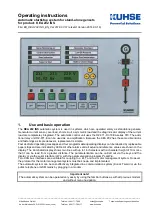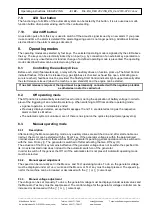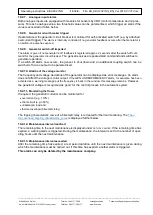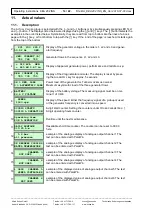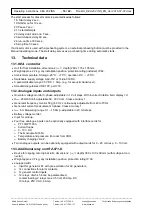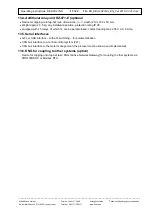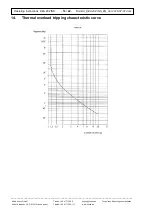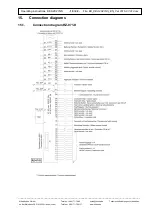
Operating instructions KEA 202 INS -
12 / 22
- File:
BA_KEA 202 INS_EN_Ver 2016-07-01.docx
______________________________________________________________________________________
Alfred Kuhse GmbH
Telefon: +49 4171-798-0
kuhse@kuhse.de
Technische Änderungen vorbehalten
An der Kleinbahn 39, D-21423 Winsen (Luhe)
Telefax: +49 4171-798-117
www.kuhse.de
10.1.
Display and acknowledgement of alarms
If there is no new actual pending, the Actual Alarms group is selected with the [→] and [←] buttons or by
simultaneously pressing LED
T
EST
and [←] button.
When a new alarm occurs, the
FAULT
♠ indicator flashes (yellow indicator in the left row of the panel). At the
same time, the acoustic signal is switched on. The horn is switched off and the display is automatically
switched to the page with the pending alarms using the
A
LARM
O
FF
button.
Either <NEW> for unacknowledged alarms or <ACKN> for acknowledged alarms comes before the text of
the pending alarm.
Unacknowledged alarm
Acknowledged alarm Display without pending alarms
The displayed alarm is acknowledged or if the fault cause is remedied, an already acknowledged alarm is
deleted by pressing the
A
LARM
O
FF
button. If all alarms are acknowledged, the Common Alarm indicator lights
up permanently. It starts flashing again with a new alarm. If all alarms are deleted, the common alarm indicator
is switched off. The pending alarms are displayed successively and can be acknowledged or deleted using the
[↑] and [↓] buttons.
From the next page (acce
ssible by pressing the [→] button), all pending alarms are displayed successively in
one second intervals. Alarms can no longer be acknowledged or deleted here
If no alarms are pending, the note -No alarms present- is displayed when opening the pages.
10.2.
Description of the alarms
10.2.1.
Engine does not switch off
If the running message of the motor is still pending after the stop time expires, the Motor does not come to a
standstill alarm is activated.
This indicates that the stop equipment (e.g. burned stopping solenoid, jam-
ming gas solenoid valve) of the motor is defective.
10.2.2.
False start
The alarm is activated if the genset has not started at the end of the start program. The automatic sys-
tem is locked for any further automatic start-up.
10.2.3.
Motor fault
The alarm starts up if the motor is already running and is brought to a standstill without a stop com-
mand. The automatic system is locked at the same time.
10.2.4.
Overspeed
For the overspeed monitoring, either the generator frequency or the frequency of a pick-up is used.
If
the generator frequency is used for detecting the overspeed, the Generator undervoltage alarm must be par-
ametrised as an alarm to be switched off in order to ensure the protection of the machine, even in the event
of generator voltage failure
10.2.5.
Alarms 13 and 14
Both these alarms are delayed by 0 to 240 sec. by the signal transmission, i.e. for the alarm contact to
issue an error, the signal must be pending for a parametrised time.
Furthermore, both these alarms are
also effective in the Off operating mode (Off), but without switching on the horn.
This means criteria (such
as tank overfilling, leakage warning) that must always be signalled can be monitored.
10.2.6.
Battery voltage monitor
On the direct monitoring output, a relay can be parameterised (at standby current) such that the message is
passed on with standby current even when in Off operating mode.
NEW GENERATOR
OVERLOAD
ACKN GENERATOR
OVERLOAD
NO ALARMS
PRESENT

